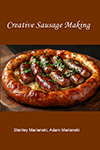Meats and Sausages
Goose or Duck Head Cheese
This traditional poultry head cheese recipe comes from The Art of German Cooking and Baking by Lina Meier, 1922.
| Materials | Metric | US |
|---|---|---|
| Goose | 8-10 lbs | |
| Calves’ feet | 6 feet |
Ingredients
- 6 quarts of water
- Salt
- 6 Peppercorns
- 2 cloves
- 1 bay leaf
- 1 large sliced onion
- Some soup greens
- 1 tsp. of meat extract
- 1/2 cup of good vinegar
- 4 whites of eggs and shells
Instructions
- The goose and calves’ feet are cleaned and well jointed, then put to boil in cold water with all other ingredients. When the goose is tender, take it out of the broth, remove all spices that may adhere to it, place it into a porcelain or stone jar. Let the calves’ feet cook until boiled down to 3 quarts, remove all fat and season with vinegar, meat extract and salt if necessary. Put in the crushed egg shells, beat the white of egg with water and add it to the bouillon, let it come to a boil and then set aside to simmer until the white of egg curdles. After one hour, strain the bouillon and pour it through a white cloth over the goose meat.*
- If you wish to prepare the head cheese quickly, omit the calves’ feet and use 35 pieces of gelatin (follow gelatin making instructions) dissolved in 3 quarts of bouillon, which is also clarified with white of egg and egg shells.
- The meat of the calves’s feet may be breaded in roll crumbs, fried in butter and served with a raisin gravy. If you wish to make this head cheese from duck, take 2 ducks.
- * If you want to produce a stuffed sausage follow the common procedure: stuff loosely into stomachs, bladders or 100 mm synthetic casings. Sew or tie the ends with twine.
- Cook in water at 85° C (185° F) for 90-180 min (depending on size) until meat reaches 68-70° C (154-158° F) internal temperature. Remove air with a needle from pieces that swim up to the surface. Spread head cheeses on a flat surface and let the steam out. Flatten stomachs with weight and cool to 6° C (43° F) or lower. Clean head cheeses of any fat and aspic that accumulated on the surface, even them out and cut off excess twine.


















